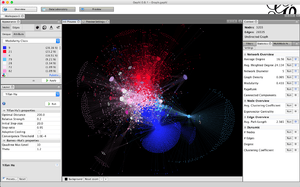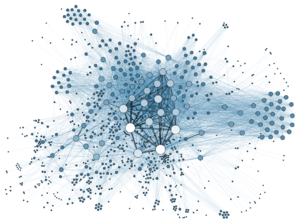Gephi
Gephi is an open-source network analysis and visualization software package written in Java on the NetBeans platform.[3]
 | |
 | |
| Developer(s) | Mathieu Bastian, Eduardo Ramos Ibañez, Mathieu Jacomy, Cezary Bartosiak, Sébastien Heymann, Julian Bilcke, Patrick McSweeney, André Panisson, Jérémy Subtil, Helder Suzuki, Martin Skurla, Antonio Patriarca |
|---|---|
| Initial release | 31 July 2008[1] |
| Stable release | 0.9.2
/ 26 September 2017 |
| Repository | |
| Written in | Java, OpenGL |
| Operating system | Linux, Windows, macOS |
| Platform | NetBeans |
| Size | 121.1 MB |
| Available in | English, Chinese, Czech, French, German, Japanese, Portuguese (Brazil), Russian, Spanish, |
| Type | Visualization |
| License | GNU General Public License, Common Development and Distribution License |
| Website | gephi |

History
Initially developed by students of the University of Technology of Compiègne (UTC)[4] in France, Gephi has been selected for the Google Summer of Code in 2009, 2010, 2011, 2012, and 2013.
Its last version, 0.9.0 has been launched in December 2015,[5] with updates in February 2016 (0.9.1)[6] and September 2017 (0.9.2).[7] Previous versions are 0.6.0 (2008), 0.7.0 (2010), 0.8.0 (2011), 0.8.1 (2012) and 0.8.2 (2013).[8]
The Gephi Consortium, created in 2010, is a French non-profit corporation which supports development of future releases of Gephi. Members include SciencesPo, Linkfluence, WebAtlas, and Quid.[9] Gephi is also supported by a large community of users, structured on a discussion group[10] and a forum[11] and producing numerous blogposts, papers and tutorials.[12]
Applications
Gephi has been used in a number of research projects in academia, journalism and elsewhere, for instance in visualizing the global connectivity of New York Times content[13] and examining Twitter network traffic during social unrest[14][15] along with more traditional network analysis topics.[16] Gephi is widely used within the digital humanities (in history,[17] literature, political sciences, etc.), a community where many of its developers are involved.
Gephi inspired the LinkedIn InMaps[18] and was used for the network visualizations for Truthy.[19]
See also
- Graph (discrete mathematics)
- Graph drawing
- Graph theory
- Graph (data structure)
- Social network analysis software
- File formats
- Dot language
- GraphML
- Graph Modelling Language
- Related software
References
- https://launchpad.net/gephi/0.6/0.6alpha1 Gephi version 0.6a1 release date
- Grandjean, Martin (2014). "La connaissance est un réseau". Les Cahiers du Numérique. 10 (3): 37–54. doi:10.3166/lcn.10.3.37-54. Retrieved 2014-10-15.
- Bastian, Mathieu; Heymann, Sebastien; Jacomy, Mathieu (2009), "Gephi : An Open Source Software for Exploring and Manipulating Networks", AAAI Publications, Third International AAAI Conference on Weblogs and Social Media, retrieved 2011-11-22
- Desmedt, Patrice (2011), "Sébastien Heymann - Le cartographe des données", L'Usine Nouvelle, retrieved 2011-12-14
- Gephi 0.9 released
- Gephi updates with 0.9.1 version
- Gephi 0.9.2 : a new CSV importer
- Liste des versions, sur GitHub
- "The Gephi Consortium - Members". The Gephi Consortium. Archived from the original on 2011-11-07. Retrieved 2011-11-23.
- Gephi Facebook group
- Gephi forums
- Grandjean, Martin (2015), GEPHI - Introduction to Network Analysis and Visualisation, retrieved 2016-08-15
- Leetaru, Kalev H. (2011), "Culturomics 2.0:Forecasting Large-scale human behavior using global news media tone in time and space", First Monday, retrieved 2011-11-22
- Aouragh, Miriyam (2011), "Collateral Damage: #Oslo Attacks and Proliferating Islamophobia", Jadaliyya, retrieved 2011-11-22
- Panisson (2011), "The Egyptian Revolution on Twitter - Featured on the PBS News Hour", YouTube, retrieved 2011-11-22
- Correa, Debora C. (2011), "Using Digraphs and a Second-Order Markovian Model for Rhythm Classification", Complex Networks, retrieved 2011-11-22
- Grandjean, Martin (2017). "Analisi e visualizzazioni delle reti in storia. L'esempio della cooperazione intellettuale della Società delle Nazioni". Memoria e Ricerca (2): 371–393. doi:10.14647/87204. See also: French version (PDF) and English summary.
- Launched in 2011 and stopped in 2014.
- Heymann, Sebastien (2011), 2010 Usage of Gephi, archived from the original on 2011-11-21, retrieved 2011-11-22
- "Pajek / PajekXXL / Pajek3XL". mrvar.fdv.uni-lj.si. Retrieved 2019-12-09.